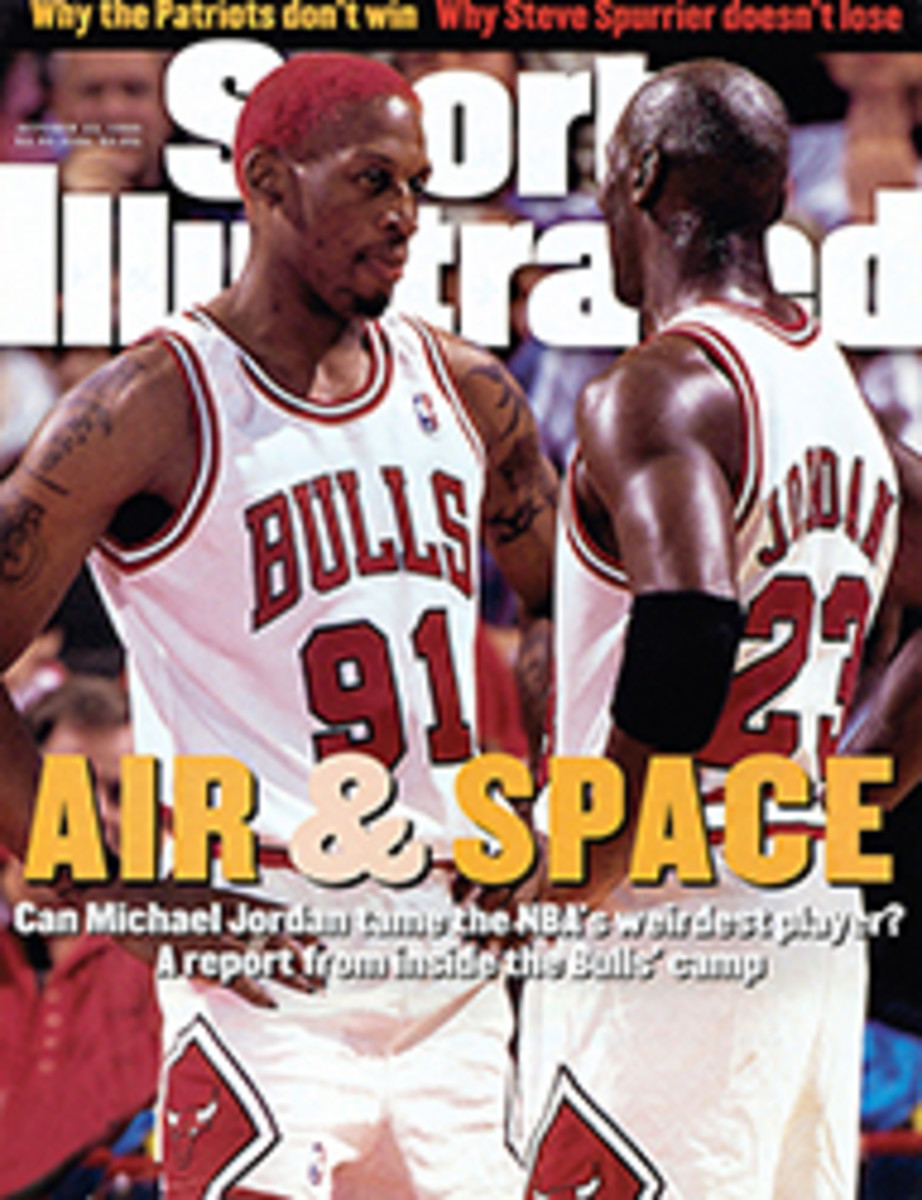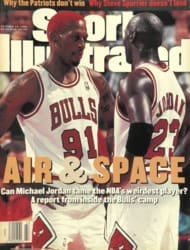
3 WASHINGTON BULLETS
Late in the afternoon of Sept. 27, 1995, Bullet general manager
John Nash, after a siege of frustration and despair, found
himself in a state of ecstasy, a mood swing achieved in a way
that only a tormented G.M. can: He'd pulled off a perfect trade.
Over the last four seasons, the 48-year-old Nash had done his
best to cobble together a winning team from medium-high lottery
choices, minor trades and free-agent signings. Despite the
limitations, he had acquired the Bullets' first true franchise
player (Chris Webber) since Wes Unseld two decades ago, a
threesome of versatile young forwards (rookie Rasheed Wallace
and 22-year-olds Webber and Juwan Howard) and a 24-year-old
swingman who may one day be an All-Star (Calbert Cheaney). Now,
if only he could get himself a quality playmaker, Nash would
have the components necessary for Washington to achieve a double
it hadn't accomplished since 1986-87: finishing above .500 and
securing a playoff berth.
Sisyphus should have had it so easy. First, Nash offered 76er
free agent Dana Barros a five-year, $15 million contract. Barros
proceeded to sign with the Boston Celtics for $21 million over
six years. Then Nash dangled a six-year, $15 million deal in
front of the Suns' Elliot Perry. But Phoenix countered with a
six-year, $12 million package, and Perry decided to stay.
Suddenly Nash was facing the prospect of either having to peddle
Wallace or Cheaney for a point guard, or having to start Doug
Overton, a career backup.
And then Cleveland Cavalier general manager Wayne Embry called.
Embry had just learned that Brad Daugherty, the Cavs' star
center, was going to miss half of the season with a back injury,
and with the team rebuilding, he wanted to know if Nash was
interested in acquiring 31-year-old Mark Price, who had only one
more year remaining on his contract. The price, it was
eventually decided, would be Washington's No. 1 draft pick in
1996.
On Sept. 27, Nash stood before the press, having effectively
borne a boulder up a hill in Hades. He announced that not only
had he acquired a four-time All-Star who was far superior to the
free-agent playmakers he had tried to get, but that he also had
not disturbed his young nucleus of talent or busted the salary
cap to do it. "I'm thrilled, but I've learned not to crow unless
I have something to crow about," Nash said. "Now, let's go win
some games."
Bullet coach Jim Lynam, charged with doing just that, was less
guarded: "We were in a position where we needed a high-level
point guard, and to come out of it with Mark Price speaks
volumes."
Indeed, Price is a three-way fit: as a floor general, as a
playoff veteran and as a hair-trigger three-point threat.
Moreover, with a front line that ranges from 6'9" Howard to 7'7"
Gheorghe Muresan, Washington could be one of the best rebounding
teams in the league, and Price was born to run. Says Wallace,
"With Mark Price pushing the ball, there's no telling how far we
can go."
Things began looking up last Nov. 17, when Nash signed Howard
(page 76), the No. 5 pick in '94, and dealt Tom Gugliotta and
three No. 1's to Golden State for Webber. The ex-Fab Fivers
immediately boosted attendance; the 30 sellouts were the most
ever in Landover, Md. But for all their individual
productivity--Howard was second-team all-rookie, and Webber's
three triple doubles were second only to Jason Kidd's four--the
Bullets still failed to win 25 games for the fourth straight year.
Price will miss the preseason because of an inflammation on the
bottom of his left foot, the same injury that hampered him late
last season. But once he's in the lineup, Webber and Howard
should at least have more room to maneuver; doubling either one
could cost teams three points. "Price will make the game easier
for them," Nash says.
So, too, will Wallace, who will play at both power forward and
center. While Muresan made giant strides last season, finishing
sixth in the league in shooting percentage (56%), he was in
constant foul trouble. With Wallace in among the Wolverines,
Washington's front line could set a standard for size,
athleticism and friskiness. "I can see us playing at the same
time and causing problems for other teams," Wallace says.
A lack of depth could be a problem; Don MacLean is battling
tendinitis in both knees and coming off surgery for a broken
right thumb. And with no No. 1 pick in '96, it's unlikely the
roster will soon get another upgrade like this one. "I think we
have a chance to be smiling--or still perspiring--in June," Nash
says. "The only thing better than basketball in May is
basketball in June, and we haven't experienced either in quite
some time here."
--H.H.
COLOR PHOTO: SCOTT CUNNINGHAM/NBA PHOTOS With Muresan (77) improving and Price on board, the Bullets are standing tall. [Gheorghe Muresan defending basket]
BY THE NUMBERS
1994-95 TEAM STATISTICS
PPG (Rank) FG% (Rank)
OFFENSE 100.5 (16) .460 (18)
DEFENSE 106.1 (25) .480 (22)
A HAPPY COLLEGE REUNION
In each of their two seasons together at the University of
Michigan, Chris Webber and Juwan Howard helped the Wolverines
reach the NCAA title game. Last season, their first as teammates
in the NBA, they finished as the top two scorers for the
Bullets. That puts them in some exclusive company: Only seven
times in league history have former college teammates ranked 1?2
in scoring average for an NBA team in any one season. Included
in that group are Clark Kellogg and Herb Williams, who did it
three straight years for Indiana in the mid-'80s (Kellogg led
the team twice and Williams once during that span).
NBA Teams with Top Two Scorers from the Same College
'94-95 Bullets Chris Webber, Michigan
Juwan Howard
'94-95 Rockets Hakeem Olajuwon, Houston
Clyde Drexler
'91-92 Lakers James Worthy, North Carolina
Sam Perkins
'89-90 Heat Rony Seikaly, Syracuse
Sherman Douglas
'83-86 Pacers Clark Kellogg, Ohio State
Herb Williams
'82-83 Nets Albert King, Maryland
Buck Williams
'49-51 Olympians* Alex Groza, Kentucky
Ralph Beard
* Indiana Olympians
PLAYER TO WATCH
Six minutes after the lockout ended at noon on Sept. 18, Calbert
Cheaney was in the Bullets' practice gym. "I kept looking at the
clock," he says. "I couldn't wait." With Rex Chapman shipped out
to Miami, Cheaney will have the 2-spot to himself, and he's
intent on raising his game a notch. Make that another notch.
Last season he lifted his totals in every statistical
department, including an absurd improvement from three-point
range: After going 1 for 23 as a rookie, he was 96 for 283 in
'94-95. His improved jumper should create more chances for him
to penetrate and draw fouls; in 78 games last year he went to
the line more than six times only twice. G.M. John Nash expects
him to make another quantum leap. "Calbert is even better," Nash
says, "than Calbert realizes."
PROJECTED LINEUP
STARTERS 1994-95 Key Statistics
SF Juwan Howard 17.0 ppg 8.4 rpg 2.5 apg
PF Chris Webber 20.1 ppg 9.6 rpg 4.7 apg
C Gheorghe Muresan 10.0 ppg 6.7 rpg 1.74 bpg
PG Mark Price 15.8 ppg 7.0 apg 91.4 FT%
SG Calbert Cheaney 16.6 ppg 4.1 rpg 2.3 apg
TOP RESERVES
F-C Rasheed Wallace Rookie; 4th overall pick, from North
Carolina
F Don MacLean 11.0 ppg 4.2 rpg 1.3 apg
G Mitchell Butler 7.9 ppg 2.2 rpg 1.2 apg

